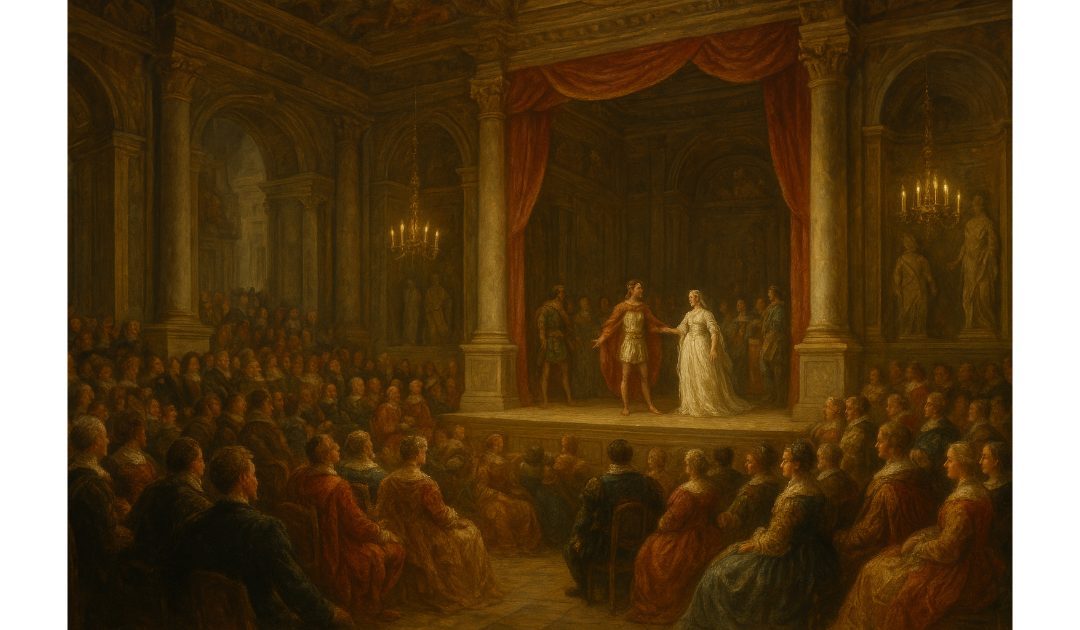There were several historical events that tempted me today. The 6th of October marked the premier of The Jazz Singer, the first talking picture in 1927. I was tempted by the start of the Yom Kippur War in 1973. Instead I have opted for Eurydice, the earliest surviving opera, which premiered in 1600. According to Wikipedia, this opera kicked off the baroque period, and I wanted to know more, because my work in progress, The Favourite Murder, the fifth book in the Sir Anthony Standen Adventures, is set around 1613 – 1617.
The dictionary tells me that baroque was originally an old jeweller’s term for a rough pearl. It came to mean characterized by an exuberant and ornate style in the arts of the 17th and 18th centuries, especially architecture and music. It can also mean elaborately or grotesquely ornate, whimsical, or bizarre.
Having continued my research a bit further, I find that Eurydice was composed by Jacopo Peri with a libretto by Ottavio Rinuccini. Eurydice premiered on the 6th October, 1600, (as we know) in Florence, Italy, as part of the celebrations for the wedding of King Henry IV of France and Marie de Medici. Wow! Sir Anthony Standen knew Marie as a child in Florence. He was spying for Francis Walsingham on her father, the Duke of Tuscany, since Walsingham thought he might be providing assistance to Mary Queen of Scots. The Suggested Assassin (book 3) features King Henry IV. I must know more about this opera.
The opera is based on the ancient Greek myth of Orpheus and Eurydice, a tale that has inspired countless artistic interpretations. In the myth, Orpheus, the greatest musician and poet, descends into the Underworld to rescue his beloved wife, Eurydice, after she dies from a snake bite. Armed with the power of his enchanting music, Orpheus persuades Hades, the god of the Underworld, to allow Eurydice to return to the living world. However, Hades imposes a condition: Orpheus must not look back at Eurydice until they have both reached the surface. Tragically, Orpheus succumbs to doubt and glances back, causing Eurydice to be lost to him forever.
In Peri’s Eurydice, the story is slightly adapted to suit the tastes and sensibilities of the time. Unlike the original myth, this opera concludes with a happy ending, where the power of Orpheus’s music and love ultimately triumphs, and Eurydice is restored to life. This alteration reflects the Renaissance ideals of harmony and the optimistic outlook characteristic of the era’s art and literature.
Musically, Eurydice is significant for its pioneering role in the development of opera as a genre. Jacopo Peri experimented with a new style of composition known as monody, which features a single melodic line with instrumental accompaniment. This style was intended to mimic the natural rhythms and inflections of speech, thereby enhancing the drama and emotional expression of the text. The opera’s score includes both recitative sections, which advance the plot through speech-like singing, and arias, which allow for more lyrical and reflective expression.
The instrumentation of Eurydice is relatively simple compared to later operatic works. The ensemble includes strings, lutes, and a continuo group of harpsichord or organ, which provides harmonic support. The emphasis is on clarity of text and emotional directness, aligning with the goals of the Florentine Camerata, a group of humanists, poets, and musicians who sought to revive the musical-dramatic traditions of ancient Greece.
Eurydice’s historical importance is further underscored by the fact that it predates Claudio Monteverdi’s L’Orfeo, another foundational opera, by seven years. Although Monteverdi’s work has often overshadowed Eurydice in terms of popularity and influence, Peri’s opera laid the groundwork for the development of the operatic form, demonstrating how music and drama could be integrated to create a powerful, unified artistic experience.

